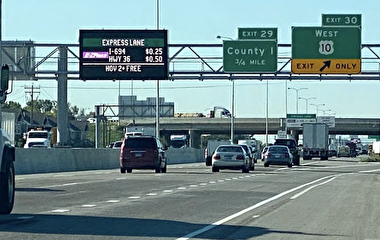While people generally support investing in transportation infrastructure, they fiercely oppose increases in user fees or taxes to support this investment. This funding problem is further compounded by the opaqueness of transportation revenue mechanisms such as the gas tax, which makes it difficult for the traveling public to easily discern how much they pay for infrastructure and what value they derive from it.
In the opening session of CTS’s 2017 research conference, Joung Lee, policy director at the American Association of State Highway and Transportation Officials (AASHTO), examined the latest direction in infrastructure funding at the federal level, offered examples of innovation happening at the state level, and discussed policy and political considerations when it comes to transportation revenue and financing tools.
“Currently, there is no political appetite to provide stable long-term funding for the Highway Trust Fund; however, the path we are on is simply not sustainable,” Lee explained. “The difference between the money going in and the money going out hasn’t matched since 2008, and in the last few years we’ve led a hand-to-mouth existence with general fund transfers. On top of that, the gas tax has lost significant purchasing power due to inflation—the price of nearly everything has increased, but the gas tax rate hasn’t been adjusted since 1993, which is the longest it has ever gone without being adjusted.”
During the 2016 presidential election, the Trump campaign had indicated support for a new $1 trillion infrastructure package, and since taking office that vision has become clearer. Trump administration officials have said they want to make targeted federal investments, encourage self-help, and leverage the private sector. “What they are essentially talking about is reducing the role of the federal government when it comes to transportation investment. They are also looking at infrastructure as a whole—everything from air traffic control to oil exploration—and not just transportation,” Lee said.
AASHTO has been working with state DOTs to advise the administration on an ideal package. “We are reminding the administration that state and local governments currently provide the largest share of transportation investment,” Lee said. “We are encouraging them to fix the Highway Trust Fund, direct a sustainable share of the federal funding to transportation infrastructure, provide direct funding and not just financing tools, focus on projects with long-term benefits and not just shovel-ready projects, streamline the project delivery process, and rely on the existing program framework rather than a top-down structure where the federal government picks projects.”
The good news, according to Lee, is that there are many ways to pay for transportation infrastructure, and states are beginning to get creative with transportation funding. “The universe is vast when it comes to technically feasible ways to pay for transportation investments—we’ve identified more than 50 ways currently being used at the state level,” Lee said. “When considering funding strategies, it’s important to be mindful of realistic yield, because it is difficult enough to increase existing [tax] rates, and new levies can be even more challenging.”
To shift the conversation about transportation investment, Lee advocates clarifying transportation’s value. “We need to do a better job communicating the benefits of the transportation system,” he said. “People have no idea what they are paying for the transportation system and how it compares to other things they depend on. By making the costs and benefits more relatable, people can begin to see that at less than $50 a month, transportation is a really good value.”




